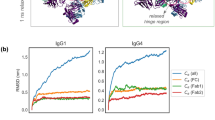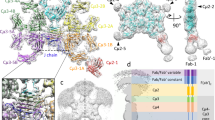Abstract
ANTIBODY molecules of the IgG class are composed of three covalently linked regions1,2. Two of these (designated Fab) are identical and bind antigen; the third (Fc) has been identified as the site of antibody effector functions (for example, complement fixation), which are activated by antigen binding3. There is evidence that the binding of antigen to the Fab region induces an allosteric transition in IgG and that this transition may be a step in the effector activation process4. The findings of Pecht et al.5 indicate that for complement fixation both Fab regions must bind antigen, even though binding to one induces some conformational change in Fc. Binding of hapten does not lead to complement fixation in general, but some exceptions to this rule are known6. The interchain disulphide bridges must be intact for Fab ligand binding to have a productive effect on the Fc region7,8. Both the Fab and Fc regions have a domain structure; each consists of a pair of compact lobes covalently linked by strands of polypeptide chains9. A schematic diagram of the connectivity of the IgG lobes is given by Padlan10. One of the fundamental questions involved in antibody function is the nature of the mechanism by which binding of antigen to the Fab regions affects the Fc region. Huber et al. have recently outlined a possible allosteric model for the activation step on the basis of X-ray and other data9. In this note we use simple diffusion arguments to estimate the characteristic times associated with the Huber proposal. Since the analysis deals only with the relative motion of the IgG domains, it is possible that slower intradomain structural changes are also involved in the activation process; if so, the estimated characteristic times would be lower bounds for the activation time. The role of conformational transitions in effector function activation is still in dispute11, but we note that the diffusional model may be useful for analysing other dynamical phenomena in immunoglobulins, such as their fluorescence depolarisation behaviour12–14.
This is a preview of subscription content, access via your institution
Access options
Subscribe to this journal
Receive 51 print issues and online access
$199.00 per year
only $3.90 per issue
Buy this article
- Purchase on Springer Link
- Instant access to full article PDF
Prices may be subject to local taxes which are calculated during checkout
Similar content being viewed by others
References
Porter, R. R. Biochem. J. 73, 119–126 (1959).
Edelman, G. M. et. al. Proc. natn. Acad. Sci. U.S.A. 63, 78–85 (1969).
Beale, D. & Feinstein, A. Q. Rev. Biophys. 9, 135–180 (1976).
Givol, D. in Receptors and Recognition A (eds Cuatrecasas, P. & Greaves, M. F.) 27–29 (Halsted, New York, 1976).
Pecht, I., Ehrenberg, B., Calef, E. & Arnon, R. Biochem. biophys. Res. Commun. 74, 1302–1310 (1977).
Goers, J. W., Schumaker, V. N., Glovsky, M. M., Rebek, J. & Müller-Eberhard, H. J. J. biol. Chem. 250, 4918–4925 (1975).
Schur, P. H. & Christian, G. D. J. exp. Med. 120, 531–545 (1964).
Schlessinger, J., Steinberg, I. Z., Givol, D., Hochman, J. & Pecht, I. Proc. natn. Acad. Sci. U.S.A. 72, 2775–2779 (1975).
Huber, R., Deisenhofer, J., Colman, P. M., Matsushima, M. & Palm, W. Nature 264, 415–420 (1976).
Padlan, E. A. Q. Rev. Biophys. 10, 35–65 (1977).
Metzger, H. Adv. Immun. 18, 169–203 (1974).
Yguerabide, J., Epstein, H. F. & Stryer, L. J. molec. Biol. 51, 573–590 (1970).
Wahl, P. Biochim. biophys. Acta 175, 55–64 (1969).
Holowka, D. A. & Cathou, R. E. Biochemistry 15, 3379–3390 (1976).
McCammon, J. A., Gelin, B. R., Karplus, M. & Wolynes, P. G. Nature 262, 325–326 (1976).
Adam, G. & Delbrück, M. in Structural Chemistry and Molecular Biology (eds Rich, A. & Davidson, N.) 198–215 (Freeman, San Francisco, 1968).
McCammon, J. A. & Wolynes, P. G. J. chem. Phys. 66, 1452–1456 (1977).
Wolynes, P. G. & McCammon, J. A. Macromolecules 10, 86–87 (1977).
Wallach, D. J. chem. Phys. 47, 5258–5268 (1967).
Karplus, M. & Weaver, D. Nature 260, 404–406 (1976).
Author information
Authors and Affiliations
Rights and permissions
About this article
Cite this article
McCAMMON, J., KARPLUS, M. Internal motions of antibody molecules. Nature 268, 765–766 (1977). https://doi.org/10.1038/268765a0
Received:
Accepted:
Issue Date:
DOI: https://doi.org/10.1038/268765a0
This article is cited by
-
Characterization of the NISTmAb Reference Material using small-angle scattering and molecular simulation
Analytical and Bioanalytical Chemistry (2018)
-
Stability and enzyme activity of lysozyme in the presence of Fe3O4 nanoparticles
Monatshefte für Chemie - Chemical Monthly (2016)
-
QSAR for RNases and theoretic–experimental study of molecular diversity on peptide mass fingerprints of a new Leishmania infantum protein
Molecular Diversity (2010)
-
Photon correlation spectroscopy of human IgG
Journal of Protein Chemistry (1988)
Comments
By submitting a comment you agree to abide by our Terms and Community Guidelines. If you find something abusive or that does not comply with our terms or guidelines please flag it as inappropriate.



